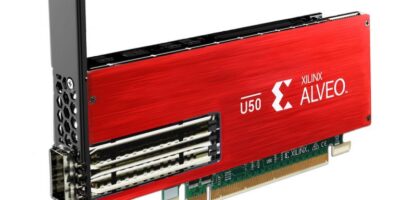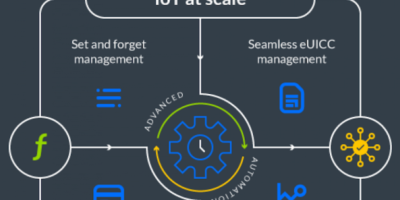Believed to be the industry’s first adaptable compute, network and storage accelerator card which delivers “dramatic improvements” in throughput, latency and power efficiency for critical data centre workloads, says Xilinx.
The Alveo U50 has been added to the Alveo data centre accelerator card range. It is claimed to be the industry’s first low profile adaptable accelerator with PCIe Gen 4 support. According to the company, it boosts a range of critical compute, network and storage workloads in a single, reconfigurable platform.
The Alveo U50 is a programmable low profile and low-power accelerator built for scale-out architectures and domain-specific acceleration of any server deployment, on-premise, in the cloud and at the edge, says Xilinx. It is intended to meet the challenges of emerging dynamic workloads such as cloud microservices and delivers between 10 to 20 times improvements in throughput, latency and power efficiency. The principle is to move the compute closer to the data to help developers identify and eliminate latency and prevent data bottlenecks and thus accelerate networking and storage.
The U50 is powered by the Xilinx UltraScale+ architecture. It is the first in the Alveo family to be packaged in a half-height, half-length form factor and low 75W power envelope. The card features high-bandwidth memory (HBM2), 100Gbit per second networking connectivity, and support for the PCIe Gen 4 and CCIX interconnects.
The 8Gbyte of HBM2 delivers over 400Gbits per second data transfer speeds and the QSFP ports provide up to 100Gbits per second network connectivity. The high-speed networking I/O also supports advanced applications such as NVM Express over Fabrics (NVMe-oF), disaggregated computational storage and specialised financial services applications.
Applications for the Alveo U50 are machine learning inference, video transcoding and data analytics to computational storage, electronic trading and financial risk modelling. For deep learning inference acceleration (speech translation), the Alveo U50 delivers up to 25 times lower latency, 10 times higher throughput and better power efficiency per node compared to GPU-only for speech translation.
For data analytics acceleration (database query), the Alveo U50 runs the TPC-H Query benchmark to deliver four times higher throughput per hour and reduced operational costs by a factor of three, compared to in-memory CPU. It also delviers 20 times more compression/decompression throughput for computational storage acceleration (compression). It also has faster Hadoop and big data analytics, and over 30 per cent lower cost per node compared to CPU-only nodes.
In electronic trading applications, the U50 delivers 20 times lower latency and sub-500 nanosecond trading time compared to CPU-only latency of 10 microseconds. In financial modelling applications, the Alevo U50 runs the Monte Carlo simulation and delivers seven times greater power efficiency compared to GPU-only performance, reports Xilinx.
Xilinx will be showcasing the Alveo U50 at the Flash Memory Summit 2019 (6 to 8 August) at the Santa Clara Convention Center in Santa Clara, California, USA.
The Alveo U50 is sampling now with OEM system qualifications in process. General availability is scheduled for Q3 2019.







